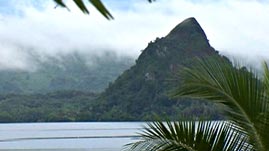Teachers' Domain - Digital Media for the Classroom and Professional Development
User: Preview

Source: GEF Pacific IWRM Project
These videos adapted from the Secretariat of the Pacific Community examine Pacific Island watersheds. In the main video, Micronesians explain how important a balanced ecosystem is to their culture and livelihoods. We learn that changes to the Nett watershed on the island of Pohnpei are harming the water supply, coral reefs, and fisheries, and that climate change may further threaten these resources. By working together to manage the watershed and the human activities that affect it, Micronesians can improve both public and environmental health. The animation describes the three zones that make up a high island watershed.
Pacific High Island Watershed Animation (Video)
Vocabulary:
In many Pacific Island cultures, ancient chiefs divided high islands into areas of land that extended from the mountains to the sea. Each area, separated by a hill or ridge, formed a watershed. Within a watershed, the land and water are connected, giving generations of islanders access to natural resources: wood from the forests, fresh water from streams, crops from planted land, and fish from coral reefs.
In a watershed, gravity makes water flow from an area of higher elevation to an area of lower elevation. Rainfall that does not get absorbed by the soil collects in streams. Streams may flow into rivers, which empty into a common body of water, such as a lake or the sea. A high island watershed typically consists of three zones: forest, river floodplain, and coastal marine. What happens in a higher zone can affect everything below it.
Since Pacific islands were first settled more than a thousand years ago, many have been transformed. Over time, farming, construction, invasive species, and growing populations of pigs and goats have loosened the soil, making the watersheds more subject to erosion. When it rains, large amounts of sediment and pollution—including sewage, pesticides, and fertilizers—are picked up from the ground’s surface and delivered to the reefs. Because fresh water is less dense than salt water, this sediment may stay suspended in the ocean for days, blocking the sunlight that corals use for photosynthesis. When the sediment finally does settle, it can blanket the corals and prevent them from feeding and reproducing.
While islanders can do little themselves to prevent climate change, local actions can reduce damage to reefs from sediment and pollution. For example, because most sediment is trapped by mangrove forests before reaching the ocean, protecting mangroves can help reduce the harmful effects of soil erosion on coral reefs. Replanting areas of a watershed that were previously cleared of vegetation and controlling the populations of wild pigs and goats can also help keep the soil from washing away and ending up on a reef.
With flooding, droughts, and major storms likely to occur more frequently with climate change, watersheds will feel even more stress going forward. On many islands, scientists are studying how these events may affect the health of the watershed and coral reefs. Their findings can help community leaders and policymakers decide which actions to take. Traditional knowledge, which understands watersheds as a system of parts that all work together, can play an important role in watershed planning.
Here are suggested ways to engage students with this video and with activities related to this topic.
Class activity: After watching the video, demonstrate the concept of sediment settling over a coral reef. Gather the following materials, and then proceed with the demonstration.
Materials:
Procedure:
1. Fill the jar almost to the top with water.
2. Add a handful of small rocks. Let them sink to the bottom.
3. Pour in some sand and stir the water.
4. Observe what happens.
Observations:
The water looks murky when the sand is first stirred into it. Soon after, the sand sinks and settles on top of and between the rocks at the bottom of the jar. Now ask students to imagine the small rocks as coral and the sand as sediment washed into the sea. The murky water blocks out the sunlight, which the corals need. As the sediment settles, it buries the coral.
Class activity: Ask students to map out their own local watershed. Have them determine the boundaries of the watershed and identify where the water originates and where it ends up. Then have them discuss what sorts of materials the water might pick up on its journey through the watershed.
 Loading Standards
Loading Standards